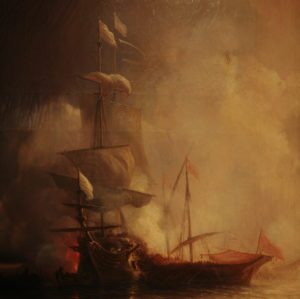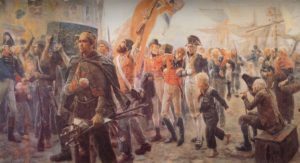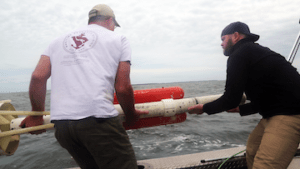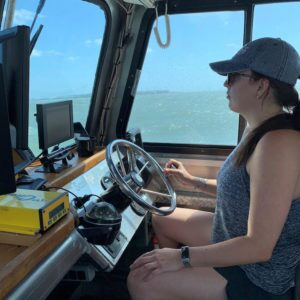
In 1577, a French corsair, Le Prince, wrecked in shallow waters near the entrance of Port Royal Sound in South Carolina. It was an ignominious end for the heavily armed, 300-ton privateer. Before its demise, it prowled the waters of the Caribbean, preying on Spanish ships, seizing cargoes and treasure, and looting coastal settlements. According to historical documents, the captain and entire crew survived the shipwreck and made their way to shore where they constructed a fort and housing. Their days, however, were numbered. Most were soon killed or taken prisoner by local Native Americans. The survivors were eventually hunted down and executed by the Spanish, who controlled the region at that time.
To this day, the remains of the Le Prince shipwreck have not been found. South Carolina State Underwater Archaeologist Jim Spirek aims to change that. Spirek is leading an exhaustive search to find and document the first shipwreck of a 16th-century French corsair. With a grant from the National Oceanic and Atmospheric Administration (NOAA) and help from the Maritime Research Division at the South Carolina Institute of Archaeology and Anthropology, Spirek is closer than ever to discovering Le Prince, and making history.
In August of 2021, I joined Jim Spirek and his team aboard their research vessel as they methodically surveyed the shoals near Port Royal Sound. I recently spoke with Spirek about the search for Le Prince and approximately 40 more shipwrecks that lay undiscovered off Port Royal Sound. In the following interview, he shared several details about the operation and what the team has uncovered:
Q: What prompted the search for Le Prince? What was your role in launching the project in 1996?
Spirek: We began the search for Le Prince when my new colleague, Dr. Chester Depratter, brought the shipwreck to my attention when I first arrived at the Institute in 1996. He knew I had worked on a 16th-century Spanish wreck in Florida and that I would most likely be interested in one here in South Carolina. He was correct, and with his assistance, I began to learn more about the circumstances of the shipwreck through historical research, mostly from translated and published Spanish documents, and I began to think about ways of conducting research in the French archives. These documents would reveal additional information about the preparations for the corsair to trade and raid along the Spanish Main and West Indies, documenting the people involved in the business venture, as well as the more mundane tasks of victualing, crewing, and outfitting a corsair during this period.
My role in the project was as the principal investigator along with my colleague Dr. Depratter, who was very interested in finding the shipwreck site as it figured very closely in with the history of Santa Elena where he was a terrestrial archaeologist, along with Dr. Stanley South, investigating the remains of the former Spanish capital of La Florida.
We started our first marine archaeological survey to locate the shipwreck of Le Prince and others in 2001 and have continued off and on throughout the years, using federal, state, and private funds.
Q: With approximately 40 undiscovered shipwrecks along the shoals off Port Royal Sound, why focus primarily on the Le Prince wreck?
Spirek: One of my primary research areas focuses on 16th-century shipwrecks and seafaring, so I obviously have a very keen interest on locating Le Prince, which wrecked in early 1577 at the entrance shoals to Port Royal Sound. The shipwreck also figures into the very early colonial history of the area with the reestablishment of Santa Elena, as French survivors lived in the area amongst the Native Americans for about three years after the shipwreck until they were ferreted out by Spanish forces by 1580. Besides the French corsair, there are many other interesting shipwrecks in the area, including a British warship from the War of 1812, and we’d be happy to find any of them for research and management purposes. But for me, with my research interest in the 16th century, Le Prince is the primary shipwreck of historical and archaeological significance in this region of the state.
Q: Why were French corsairs, such as Le Prince, sailing along that stretch of coast during the 16th century? What were they doing?
Spirek: Corsairs sailed along the Southeastern coastline during this period to refresh, seeking water, foodstuffs, and perhaps to trade with Native Americans, prior to undertaking the transatlantic voyage back to France. As for Le Prince, we’re not 100 percent sure why they decided to come to Port Royal Sound. Previously, they had stopped at St. Augustine to engage in trade or raid the Spanish town, but a storm drove them off and subsequently they sailed further north along the coast before they wrecked on the shoals at Port Royal Sound.
Q: What have you and the MRD team discovered thus far about Le Prince? What information has your historical research in France and Spain revealed?
Spirek: From an archaeological viewpoint, we haven’t found Le Prince yet, and we continue to methodically cover the suspected area of the wreck site. We do have a few targets that we need to ground truth, or inspect by diving, to see if any are related to Le Prince or any of the other shipwrecks historically recorded in the area. At this point, we can confidently state we know where Le Prince isn’t.
Results of our historical research, on the other hand, have been more fruitful in that we have found numerous documents in French and Spanish archives related to the French corsair. Our researcher in the French archives has uncovered a trove of documents dating from the late 1560s to 1576 that provides glimpses of the early history of Le Prince. The vessel in the late 1560s was commanded by Huguenot or Protestant corsairs attacking Portuguese and Venetian ships at the Azores Islands and strait of Gibraltar. Later the vessel was captured by Catholic forces at La Rochelle in 1573 during the Fourth War of Religion and then home-based in Le Havre where the vessel and others later caused trouble for English shipping in the Channel.

Public Domain, Wikimedia Commons
Spanish documents uncovered by our researcher in the Spanish archives documented the corsair’s movements in the Caribbean, including attacking vessels and towns and engaging with the Spanish Armada off the coast of present-day Haiti. These archival materials supplemented other translated and published documents about La Florida that included elements of the corsair’s exploits in the Caribbean, but primarily detailed the tribulations of the survivors from the shipwreck, Native American attack, and the methodical hunt by the Spanish to round up the Frenchmen.
__________________________________

Le retour des corsaires. 1806. Painting by Maurice Orange, Public Domain, Wikimedia Commons
__________________________________
Q: How are you conducting surveys of the shoals? What types of equipment are you using?
Spirek: We are conducting marine archaeological prospecting of the shoals using a suite of marine electronic equipment that consists of several devices. Our primary instrument is a cesium magnetometer that’s used to detect ferromagnetic materials such as iron or steel, or cannons, anchors, rigging, and other components associated with shipwrecks. We also use a side-scan sonar which acoustically pictures the bottom so if there’s any material standing above the bottom it will be pictured. Afterwards, we correlate the magnetometer data with the sonar data to get an idea of what could be down there. Is it a ballast pile of rocks or other components that suggest a shipwreck? There are all kinds of objects that can be on the bottom, such as dredge pipes, wire and cables, cars, crab traps, etc. Usually, the closer we are to a harbor the more debris there is that we must sort through to try and find anything of historical or archaeological significance. We also use on occasion a sub-bottom profiler that sends a low frequency acoustic signal that penetrates below the bottom. This will hopefully reveal something buried that the magnetometer detected, but not by the side-scan sonar which suggests that the magnetic anomaly is buried. Then we can run over the target with the sub-bottom profiler to try and determine if it is something of interest.
________________________________

Will Nassif minding the data acquisition and Jim Spirek steering the vessel. (SCIAA photo).
________________________________
Q: How deep are the areas you’re surveying?
Spirek: As we are surveying on and around the shoals at the entrance to Port Royal Sound the depths are primarily shallow. Depths range from several feet in proximity to the sandbars during low tide, although there is an area of deeper water about 70 feet near the channel. However, for the most part, the depths range from 25 to 30 feet or thereabouts, depending on the tide.
Q: What is a typical day of offshore surveying like?
Spirek: A typical day of survey includes heading to the boat ramp and getting the boat ready in the morning by re-connecting our laptop to the equipment, starting the generator for shipboard power, and getting our personal gear aboard. After dropping the boat in the water, we head offshore and travel time to the survey area varies from about 45 minutes to an hour depending on the weather and sea state, and if we’re working closer inshore or further offshore. Weather and sea states always dictate how far offshore we can go. We prefer glassy conditions in which we can methodically “mow the lawn” back and forth over the survey area without too much trouble although sometimes it does get a little bit lumpy out there, particularly in the afternoon. If it gets too bad, we oftentimes head in closer to the sound entrance to hopefully find a lee shore from the wind and waves sheltered by one of the islands that form the entrance. Usually, we stay out about six hours before heading back to the landing where we reverse what we did in the morning by disconnecting the computers and taking our stuff off. We then head back to where we are staying and rinse the boat, flush the engines with freshwater, and do any needed maintenance or repairs to the vessel or equipment. In the evening after dinner, we’ll start post-processing the magnetic and acoustic data to begin building a target list to obtain additional electronic data and ground-truthing by diving later in the project.
________________________________

Jim Spirek and Ryan Bradley tossing the cesium magnetometer sensor into the sea. (SCIAA photo).
________________________________

Athena Van Overschelde keeping the boat online using the helmsman display. (SCIAA photo).
________________________________
Q: What’s the most difficult challenge you’ve encountered?
Spirek: Any time working with electronic equipment and boats on the water there are always issues related to equipment problems. For instance, our laptop began resetting itself due to an internal battery issue that required us to re-boot every two hours. Although we did fix the problem, it caused us to ready another laptop for data acquisition and now we have redundancy in the event the old laptop starts giving us problems again. Since our boat is what keeps us on the water, we baby the engines and service them regularly. Fortunately, our equipment issues have been minor in nature and nothing that money can’t fix. Our main challenge is always the weather and sea state that impacts how long and where we can work offshore. Our main aim when surveying is to make it as boring as possible, that is to not have any major issues or have an “adventure.” We simply want to keep “mowing the lawn” and making progress to find Le Prince and other shipwrecks on the shoals.
Q: How confident are you that you’re searching in the right area? Has that section of coastline changed much since the 16th century?
Spirek: We feel confident that we’re looking in the right area for Le Prince based on historical Spanish documents, including one account by a Franciscan friar who wrote that the shipwreck occurred about a league from the shore, which is about three miles, and another reported observing the poop deck, or the upper deck stern structure of the ship, had been pulled into the marshes. These two accounts suggest the corsair wrecked close to shore, especially since the poop deck was drawn into the sound.
Regarding physical changes to the shoreline, there is no doubt the shoreline has changed over time, but the channel has remained fairly constant due to the strong ebb flow through the natural inlet. To account for changes to the shoals and shoreline our primary survey area encompasses a large area that extends approximately seven miles to the sea entrance at the bar and spans seven miles wide.
Q: How close are you to finding Le Prince?
Spirek: Currently, we know where Le Prince isn’t so we hope that means we’re getting closer to where Le Prince is.
Q: When you locate the Le Prince wreck, what exactly do you expect to find?
Spirek: If we do find the remains of Le Prince, we’d expect to find the lower wooden hull of the shipwreck embedded in the bottom, perhaps with an exposed area of ballast stones, and surrounded by heavier metallic components, such as anchors and cannons. Historical accounts state the corsair was heavily armed with about 40 artillery pieces, although we do know that the survivors salvaged one bronze cannon so that means there’s about 39 large cannon remaining, comprised of a mix of iron and bronze pieces. Besides metallic objects, we’d hope to find some evidence of the spoils of their depredations along the Spanish Main and the West Indies, perhaps some gold coins and pearls. We also know they took onboard numerous foodstuffs stored in ceramic olive jars while in Cuba and assume either whole jars or sherds survive, including organic preservation of their contents. Besides preserving objects from the last voyage, another class of artifacts more deeply buried in the ballast rocks, among the frames of the hull, and in the bilge, no doubt survive that are related to the life of the ship, from when it was built and from previous voyages. These include former cargoes, broken ceramics, and faunal and floral remains that upon examination may reveal more about the sailing career of the corsair.
Q: What do you hope to learn from the shipwreck? What could the remains of Le Prince teach us?
Spirek: [Although historically] overshadowed by the exploits of the British in the Caribbean, particularly by John Hawkins and Francis Drake, the French were the first to contest Spain’s New World claims through corsairing operations, and later colonial endeavors. Discovery of Le Prince would launch a research effort to learn about these activities as well as increase our understanding of their role in the development of the New World. From a nautical archaeological point of view, the discovery and examination of this ship would reveal a component currently absent from the archaeological record associated with the early exploration, colonization, and contention of the New World—a 16th-century French corsair shipwreck.
Q: In addition to Le Prince, what other shipwrecks are you hoping to discover?
Spirek: Besides searching for the wrecked French corsair, historical records indicate approximately 40 other shipwrecks occurred in the vicinity of Port Royal Sound. A Spanish vessel wrecked on the shoals in the 16th century and perhaps we’ll stumble upon that one during our survey operations. From the late 16th to late 17th century, there is an interlude of known shipwrecks occurring. It begins to increase in about the late 1700s when Charleston, and later Beaufort and Savannah, are established, which results in an increase of shipping traffic in the region. These unfortunate victims of the shoals primarily consist of British colonial vessels until the American Revolution, and then transition to US vessels, interspersed with a few foreign ones. One intriguing wreck is the HMB Colibri, which wrecked after leading a marauding expedition against local Sea Island plantations during the War of 1812.
Q: How important are these shipwrecks to understanding the region’s maritime history?
Spirek: Shipwrecks provide a tangible link to the maritime history and development of Port Royal Sound from the early period of European explorations, particularly related to rival Spanish and French counter claims to the territory, followed by British colonial pursuits, and commercial progress as part of the United States. Each of the shipwrecks off Port Royal Sound provides a glimpse of their individual role that, combined with the others, broadens our understanding of the maritime history of the region and the world.
Cover Image, Top Left: Battle of a French ship of the line and two galleys of the Barbary corsairs, Painting buy Theodore Gudin, Public Domain, Wikimedia Commons
______________________________________
Advertisement




